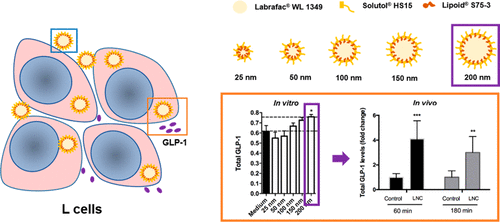当前位置:
X-MOL 学术
›
Mol. Pharmaceutics
›
论文详情
Our official English website, www.x-mol.net, welcomes your
feedback! (Note: you will need to create a separate account there.)
Size Effect on Lipid Nanocapsule-Mediated GLP-1 Secretion from Enteroendocrine L Cells
Molecular Pharmaceutics ( IF 4.5 ) Pub Date : 2017-12-15 00:00:00 , DOI: 10.1021/acs.molpharmaceut.7b00742 Yining Xu 1 , Dario Carradori 1 , Mireille Alhouayek 2 , Giulio G. Muccioli 2 , Patrice D. Cani 3 , Véronique Préat 1 , Ana Beloqui 1
Molecular Pharmaceutics ( IF 4.5 ) Pub Date : 2017-12-15 00:00:00 , DOI: 10.1021/acs.molpharmaceut.7b00742 Yining Xu 1 , Dario Carradori 1 , Mireille Alhouayek 2 , Giulio G. Muccioli 2 , Patrice D. Cani 3 , Véronique Préat 1 , Ana Beloqui 1
Affiliation

|
L cells are enteroendocrine cells located throughout the gastrointestinal tract that secrete physiologically important peptides. The most characterized peptides secreted by L cells are the peptide YY (PYY) and the glucagon-like peptides 1 (GLP-1) and 2 (GLP-2). These peptides are released rapidly into the circulation after oral nutrient ingestion. Recently, lipid-based nanoparticles (NP) have been described as triggers for GLP-1 secretion by L cells. NP physicochemical properties play a key role in the NP–cell interaction, and drive NP cell internalization. We herein hypothesize that lipid-based NP with appropriate size would not only be able to deliver drugs into blood circulation but also act like endogenous ligands to stimulate GLP-1 secretion. We tested five different size (25, 50, 100, 150, and 200 nm) lipid nanocapsules (LNC) on murine L cells in vitro to confirm this hypothesis. Our study showed that GLP-1 secretion was induced only by the 200 nm size LNC, highlighting the importance of LNC particle size on the secretion of GLP-1 by L cells. The different formulations did not affect proglucagon mRNA expression, suggesting that there was not an increased GLP-1 synthesis. As a proof of concept, we further demonstrated in normoglycemic mice that 200 nm LNC administration increases GLP-1 levels by 4- and 3-fold compared to untreated control mice 60 and 180 min after the administration, respectively. Our study suggests that 200 nm LNC as a nanocarrier to encapsulate drug candidates and as a ligand to induce endogenous GLP-1 secretion might represent a promising strategy for type 2 diabetes mellitus treatment.
中文翻译:

肠内分泌L细胞对脂质纳米胶囊介导的GLP-1分泌的大小影响
L细胞是位于整个胃肠道的分泌内分泌细胞,可分泌生理学上重要的肽。L细胞分泌的最具特征的肽是肽YY(PYY)和胰高血糖素样肽1(GLP-1)和2(GLP-2)。口服营养物质摄入后,这些肽会迅速释放到循环系统中。最近,基于脂质的纳米颗粒(NP)已被描述为L细胞分泌GLP-1的诱因。NP的理化特性在NP与细胞的相互作用中起着关键作用,并驱动NP细胞的内在化。本文中我们假设具有适当大小的基于脂质的NP不仅能够将药物递送到血液循环中,而且还像内源性配体一样起刺激GLP-1分泌的作用。我们测试了五种不同的尺寸(25、50、100、150,体外证实这一假设。我们的研究表明,只有200 nm大小的LNC才能诱导GLP-1的分泌,这突显了LNC粒径对L细胞分泌GLP-1的重要性。不同的配方不影响胰高血糖素原mRNA的表达,表明GLP-1的合成没有增加。作为概念的证明,我们在正常血糖小鼠中进一步证明,与未治疗的对照小鼠相比,在给药后60分钟和180分钟,给予200 nm LNC可使GLP-1水平分别提高4倍和3倍。我们的研究表明200 nm LNC作为封装候选药物的纳米载体和作为诱导内源性GLP-1分泌的配体可能代表2型糖尿病治疗的有前途的策略。
更新日期:2017-12-15
中文翻译:

肠内分泌L细胞对脂质纳米胶囊介导的GLP-1分泌的大小影响
L细胞是位于整个胃肠道的分泌内分泌细胞,可分泌生理学上重要的肽。L细胞分泌的最具特征的肽是肽YY(PYY)和胰高血糖素样肽1(GLP-1)和2(GLP-2)。口服营养物质摄入后,这些肽会迅速释放到循环系统中。最近,基于脂质的纳米颗粒(NP)已被描述为L细胞分泌GLP-1的诱因。NP的理化特性在NP与细胞的相互作用中起着关键作用,并驱动NP细胞的内在化。本文中我们假设具有适当大小的基于脂质的NP不仅能够将药物递送到血液循环中,而且还像内源性配体一样起刺激GLP-1分泌的作用。我们测试了五种不同的尺寸(25、50、100、150,体外证实这一假设。我们的研究表明,只有200 nm大小的LNC才能诱导GLP-1的分泌,这突显了LNC粒径对L细胞分泌GLP-1的重要性。不同的配方不影响胰高血糖素原mRNA的表达,表明GLP-1的合成没有增加。作为概念的证明,我们在正常血糖小鼠中进一步证明,与未治疗的对照小鼠相比,在给药后60分钟和180分钟,给予200 nm LNC可使GLP-1水平分别提高4倍和3倍。我们的研究表明200 nm LNC作为封装候选药物的纳米载体和作为诱导内源性GLP-1分泌的配体可能代表2型糖尿病治疗的有前途的策略。











































 京公网安备 11010802027423号
京公网安备 11010802027423号